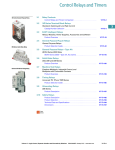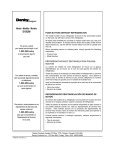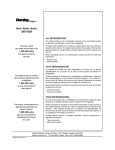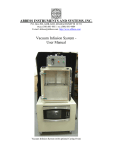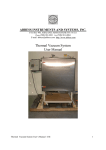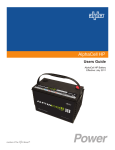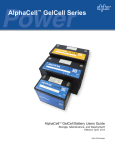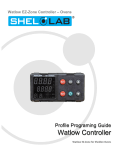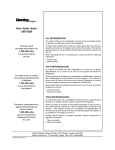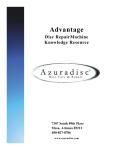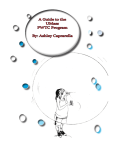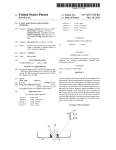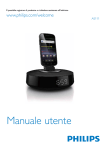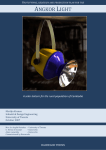Download Thermal Vacuum System User Manual |
Transcript
A B B ESS I NST R U M E N TS A N D SYST E MS, I N C. P.O. Box 498, ASHLAND, MASSACHUSETTS 01721 Phone (508) 881-8811 Fax (508) 881-4884 E-mail [email protected] http://www.abbess.com Thermal Vacuum System User Manual | Thermal – Vacuum System User’s Manual –NASA GSFC~Heymsfield 1 T A B L E O F C O N T E N TS Introduction Safety Considerations – Read before operation Installation Chamber Location and Set-Up V acuum System Description T echnical O peration and E quipment Description Vacuum Cycle Controller Sequence of Operation M aintenance and C leaning C alibration Service and Returns Shipping – C laims for Damage or Shortage W ar ranty Contacting A bbess Instruments A dditional Documentation A ppendix A W atlow E Z-Z O N E P M – PI D T emperature Controller Setup A ppendix B Instru T ech C V M 301 -Setting Instructions Control Schematic: Basic Digital with H eat V C C Product L iterature/M anuals Separately E nclosed A lcatel/A dixen A C P-40 W atlow T emperature Control V albia P A V Thermal – Vacuum System User’s Manual –NASA GSFC~Heymsfield 2 INTRODUC TION Abbess Instruments’ Thermal Vacuum Chamber Systems are designed and produced for use in production and testing applications requiring an exposure to or process within a controlled vacuum environment at specific temperature. The chambers are often custom designed for specific end-user requirements in recreating extreme atmosphere and temperature situations. Our customers use our full range of vacuum systems for testing or degassing packaged products, liquids and solids, EMI and altitude testing of electronics, computers and complete systems, shock impact targets, plasma science, space simulation and degassing large parts or components for research, and development. Abbess designs rugged equipment for continuous manufacturing and production use, with safety and a long life in mind. The Vacuum chambers are constructed of heavy aluminum, steel or stainless steel. They have customer replaceable O-ring seals which are designed to withstand repeated closings. Two latches are used to close the standard front-hinged door. All cube chambers are He leak tested to a rate of 10e-7 cc/sec or better as required and should maintain this for its life dependent on seal condition and customer use. Most Vacuum Chamber systems are made up of these basic functional components: Chamber: a vacuum container or chamber. Pump: a vacuum pump or other means of creating a vacuum. Hose: a hose, plumbing or tubing needed to connect the chamber to the pump. Valves: to control vacuum and release/break the vacuum. Vacuum Pressure Gauge: to measure actual pressure inside the chamber. Monitoring and control of the systems are attuned to specified process needs and configured to both optimize the end use operation time and assure the proper cycling of vacuum equipment. Visual monitoring of the Chamber interior is made possible through a view window in the chamber door or clear acrylic door construction. Vacuum and thermal systems are integrated into the overall system control allowing for continuous operator involvement in operations within the chamber. Thermal – Vacuum System User’s Manual –NASA GSFC~Heymsfield 3 SA F E T Y C O NSI D E R A T I O NS – R E A D T H IS SE C T I O N B E F O R E O PE R A T I O N T his equipment is designed for use in manufacturing or laboratory environments by trained technicians. Use of this equipment beyond its stated intended purpose and operating parameters is not recommended and will be the sole responsibility of the user. T his equipment should not be modified or altered. A bbess Instruments assumes no liability for any misuse of or modification to this product and such misuse or modification will immediately void all war ranties. This equipment should be used in accordance with the operating instructions contained in this manual. For alternative uses not covered in this manual, please contact Abbess Instrument’s technical department for product suitability, safety, and alternative operating instructions. The following are general safety guidelines recommended when using this product. Please consult your laboratory safety officer for any additional safety steps that may be necessary for your specific application or material. M ake sure your operator reads and understands this manual before operating the equipment. 2. This equipment is to be operated indoors only. 3. This equipment is to be operated in a well-lit area. 4. This equipment is to be operated with an ambient temperature of between 10 degrees C and 40 degrees C. 5. This equipment is to be operated with an ambient humidity of between 20 and 85 percent. 6. Thoroughly review your MSDS (Material Safety Data Sheets) for all chemicals to be used with this equipment. 7. If the equipment is fitted with an optional internal thermal source (i.e. Thermal Plate) the user must ensure that temperatures do not exceed the auto ignition point(s) of materials placed in chamber. 8. Hand and eye protection are required when using this product. Additional protection may be required with respect to the materials being used. Please consult your laboratory safety officer. 9. This product should only be used with adequate ventilation. 10. A trained electrical technician should conduct repairs of electrical components. Incorrect replacement parts or assembly may damage the product and create a serious safety hazard for the user. Factory repair is highly recommended. 11. The use of samples containing ether based, fuel, munitions, or other extremely flammable or explosive materials, compounds, or residues should not be used in this equipment. 12. Use of acidic or base material may damage this product and are not recommended unless the product was ordered with the optional protective coating in Teflon or made of Stainless steel. 1. Thermal – Vacuum System User’s Manual –NASA GSFC~Heymsfield 4 Installation Chamber Location and Set-Up Equipment must be SET-UP and installed in a LOCATION meeting the following criteria and with attention paid to the following areas of concern: - This equipment is to be operated indoors only. - This equipment is to be operated in a well-lit area. - This equipment is to be operated with an ambient temperature of between 10 degrees C and 40 degrees C. - This equipment is to be operated with an ambient humidity of between 20 and 85 percent. This equipment is to be operated on a stable floor, deck, or platform capable of safely supporting it and the intended operation. - This equipment maybe secured to the floor, deck or platform as required. - Electrical power connections should be provided as required by licensed professional trades people and in compliance with all applicable codes and ordinances. - Adequate ventilation for people, process, and equipment must be provided. - All system components must be assembled, calibrated, tested, and secured as needed for the safe and specified operations. Thermal – Vacuum System User’s Manual –NASA GSFC~Heymsfield 5 Vacuum System Description The Abbess/NGSFC-Heymsfield Thermal Vacuum System allows items placed inside to be exposed to high vacuum pressure as well as extreme temperatures via the electrically heated and refrigerant cooled Thermal Plate and Shroud System. The entire system can be controlled manually, by starting/stopping the pump(s) and opening/closing valves. A Vacuum Cycle Controller (VCC) can is used to automate vacuum cycle control functions. The VCC enables system control via panelmounted buttons. The Vacuum System consists of the following major components (See Figs. 1 - 7): Vacuum Chamber - A front loading Stainless Steel Cube Vacuum Pump- Alacatel/Adixen ACP40 Roots Type Dry Pump Thermal Plate – Copper Thermal Plate and Shroud System mounted within chamber with heating elements and separate closed loop cascade refrigerant and open loop N2 cooling systems. Feedthrough for electrical power, thermocouple and cooling lines extend through the rear wall of the chamber. The plate allows heating/cooling of items in the chamber under vacuum and the different cooling modes are controlled by PID temperature Controllers mounted in Process Control Enclosure. Mobile Cart – Heavy-duty cart/stand with chamber and pumping system mounted. Thermal Vacuum Control Enclosure – Contains component necessary for controlling thermal systems as well as logic and interfaces for the Vacuum Cycle Controller. Vacuum Gauge Control Register – Provides pressure display per remote Pressure Transducer and set point value control. Also provides pressure set-point relays that can be used for various system control functions. Process Timer Control Vacuum Cycle Controller – Control ON/OFF buttons, main power switch. Watlow Temperature Controllers and Limits(See manufacturer specific documentation). Status Indicators – Provide visual indication of system status. Pressure Transducer – Pressure Transducer attached directly to chamber communicates sensor readings to remote pressure display/interface at Controller. Control Valves Automatic Vent & Vacuum Valves – Automatic Electromagnetically actuated valves evacuate the chamber (via the vacuum pump system) and vent air into chamber based on control input from Thermal Vacuum Cycle Controller. Automatic Cryo Valves – Automatic solenoid valves allow refrigerant gas into the engaged piping system at the Thermal Shroud. Flow of LN2 to the Thermal Plate is regulated via Proportionally Actuated Valves serving two engaged piping loops arranged in a cross flow configuration. Valve actuation is based on control input from Theramal Vacuum Cycle Controller. Thermal – Vacuum System User’s Manual –NASA GSFC~Heymsfield 6 Clear Acrylic Door At S.S. Cube Chamber Thermal Vacuum Cycle Controller Thermal Plate and Shroud System (shown w/shroud front plate removed) Closed Loop Cascade Refrigeration System mounted below. Mobile Caster Cart Figure 1 – Front View of Thermal Vacuum System Figure 2 – Detail View of Thermal Vacuum Control Thermal – Vacuum System User’s Manual –NASA GSFC~Heymsfield 7 Cryo Solenoid Valve (LN2 Supply to Shroud) Power/T-CPL Feedthru For Thermal Plate and Shroud (shown w/o enclosure) Vacuum Manifold W/Solenoid Vent and ElectroMag Right Angle Vacuum Valve (Hose connect to pump not shown) PAV Cryo Valves At Feedthrus for LN2 To Thermal Plate Insulated Line from Closed Loop Cascade To Thermal Plate Alcatel/Adixen ACP-40 Dry Roots Pump Figure 3 – Rear View of Thermal Vacuum System Figure 4 – Detail View of Vacuum Manifold Thermal – Vacuum System User’s Manual –NASA GSFC~Heymsfield 8 Figure 5 – Rear View of Thermal Vacuum System (Protective Enclosures shown) Vacuum Pressure Sensor Process Ports (Feedthru TBD by Customer) Rear of TVCC Enclosure Figure 6– Detail View of Vacuum Pump Thermal – Vacuum System User’s Manual –NASA GSFC~Heymsfield 9 Power Indicator and Switch Plate Fault Test Switch Vacuum Gauge Controller Emergency Stop Process Indicators Start and Stop Button Controls Figure 7– Thermal Vacuum Cycle Control Detail Plate and Shroud Process Indicators New PM6 Controllers and Limits for Plate and Shroud LN2 Systems Note: Toggle provided switches between plate cooling modes (LN2/Refrigeration) Thermal – Vacuum System User’s Manual –NASA GSFC~Heymsfield 10 Thermal Vacuum Cycle Controller - Theory of Operation The system’s pressure level is controlled via setpoint management by the InstruTech VGC 301 controller, opening and closing solenoid and electromagnetically actuated right angle valves at the vacuum manifold at rear of the chamber. Evacuation of the chamber is facilitated by the Alactatel/Adixen ACP-40 Dry Roots Type Vacuum Pump. Vacuum Cycle Soak Time is regulated by an Eaton TRL04 timer internal to the control enclosure. The system’s temperature is controlled by three (3) Watlow PID controllers. The temperature of the thermal plate within the chamber can be controlled by either the PM6 Watlow labeled “Nitrogen” on the far left of the control box or by the F4 Watlow labeled “refrigerator” located in the center of the control box. Both controllers use the same circuitry to heat the plate and are monitored by the same limit Watlow that will cut power to both Watlows if temperatures reach unsafe levels. In addition to the Limit Controllers a manual toggle Plate Fault Test switch also interrupts power. o The PM6 Watlow on the left of the control box uses two liquid nitrogen cooling circuits configured in a counter flow configuration and metered by proportioning valves to rapidly cool the thermal plate to as low as -180C. o The F4 Watlow manages a cascade refrigerator to cool the plate to -80C without using any liquid nitrogen. Control of the thermal plate can be switched between the two Watlows using the switch located between the two Controlers. When refrigeration control is selected, the refrigerator will constantly run in conditions below 20C and will only turn on as needed at temperatures above 20C. It should be noted that the low temperature compressor of the refrigerator is on a time delay so the user may not see cooling immediately after set point change. The thermal shroud is controlled and monitored separately by its own PM6 and limit Watlows located on the right side of the control box. The PM6 controller uses a liquid nitrogen circuit controlled by normally closed solenoid valves to cool the thermal shroud and rod heaters the heat the shroud independently of the thermal plate. Thermal – Vacuum System User’s Manual –NASA GSFC~Heymsfield 11 Thermal Vacuum Cycle Controller - Sequence of Operation 1. The operator can load the open chamber at atmospheric pressure and ambient temperature. 2. Secure the chamber with the latches. 3. Close and check all manual vent valves. 4. All the temperature and pressure and process timer parameters are pre-set and tested before shipment. (Setup for each Watlow Controller is attached in Appendix to this manual. Refer to component product literature [pdf files provided on CD] for further detailed instructions.) 5. On the Thermal Vacuum Cycle Controller (grey panel) switch on the POWER. - The power light indicator will turn on. (YELLOW) - Temperature Controllers (Watlow EZ-Zone PM and Limits) will turn on. - Pressure Controller (Instrutech- VGC-301) will turn on. - The operator may enter temperature set points using the Up and Down arrow on the Temperature Controllers. 6. On the Vacuum Cycle Controller (grey panel) press the START button (Green). - The Pump will begin to pump down the Chamber. 7. To stop the system operation press the STOP button (Red) on the Vacuum Cycle Controller (grey panel). The pump will shut down. NOTE: Opening to the chamber to lab/atmosphere conditions with thermal elements at extreme temperature can cause damage to system components and introduce debris and contaminants to the chamber environment. Once the chamber pressure and temperature have reached levels equivalent with ambient conditions it is safe to open and access the chamber. Thermal – Vacuum System User’s Manual –NASA GSFC~Heymsfield 12 Maintenance and Cleaning Cleaning the Stainless Steel Components - The Stainless Steel components may be cleaned with a cleaner approved for use with Stainless Steel. Non-abrasive cleaners are recommended to preserve the surface finish. Non-abrasive scouring pads are recommended. Scrapers and non-metallic scouring pads may be used on heavily soiled areas. If scrapers are used caution must be used to not damage the chamber surface. Rinse all areas with water using a sponge or towel. Dry thoroughly. NOTE: DO NOT RINSE ELECTRICAL EQUIPMENT UNDER RUNNING WATER!!! Recommended Cleaning Agents (Cannot contain oil) Sheila Shine – Stainless Steel cleaner and polish Simple Green – All purpose cleaner Orange Clean – All purpose cleaner non-abrasive non-abrasive non-abrasive Decontamination – No hazardous materials are used in this equipment. In the event of a hazardous material spill by the user or outside source, immediately contact your laboratory safety officer or the manufacturer of the material for instructions on clean up or other decontamination procedures. Reference your Material Safety Data Sheets (MSDS) for instructions on proper clean-up and handling procedures. Calibration Calibration of all components is subject to user’s internal calibration standards. Thermal – Vacuum System User’s Manual –NASA GSFC~Heymsfield 13 Service and Returns In the event a product purchased from Abbess Instruments needs service or must be returned please follow the outlined procedures below Contact Abbess Instruments Technical Support Department Before returning any product to Abbess Instruments for any reason, please contact Abbess Instruments at 508-881-8811. Support is available Monday through Friday from 8:30 AM to 5:00 PM EST. Support is available free of charge to customers of Abbess Instruments in good standing for all products sold by Abbess Instrument. Pack the Product for Return Shipment The product should be packaged in its original shipping carton or crate if available. If other packaging is required, use a suitable shipping container, which will allow a minimum of 2 inches clearance between the product and the walls of the shipping carton or crate. Peanuts, semi rigid foam, cardboard, and other items may be used inside for packaging. Care should be taken when packaging heavy items. Some packaging, such as peanuts, will allow the item to shift in transit and may result in damage. Insurance Most common carriers offer insurance. UPS and Federal Express automatically insure your product up to $100 without charge. It is highly recommended that you insure your product. Abbess Instruments is not liable for any return shipping damages. Documentation When returning items to Abbess Instruments, a packing slip or other document must be included with the following information: Contact person’s name and phone number, return address, and statement of the problem. How Will Your Return be Handled? Abbess Instruments will evaluate the returned item for damage. If the return is a repair, the product will be examined for problems and a repair estimate will be made. The contact person will be contacted, at which time a Purchase Order will be requested. After the PO is issued, the product will be repaired and return shipped. The repair will be done in an expeditious manner. The contact person will be notified immediately in the event any shipping damage has occurred. Thermal – Vacuum System User’s Manual –NASA GSFC~Heymsfield 14 Shipping – Claims for Damage or Shortage Abbess Instruments makes a sincere effort to ensure your purchase is properly packed and all items listed on the packing slip are in fact enclosed with the shipment. In the event that your purchase is damaged or if any items are missing, please follow the procedures below. All packaging material must be retained until the issue is resolved. Thoroughly search all packing material for missing items. Review your packing list for back ordered items and the manual for a list of items affiliated with your purchase. Contact Abbess Instruments immediately at 508-881-8811. Carrier is responsible for breakage in transit! Goods shipped by Abbess Instruments were delivered to the carrier in good condition. They were packed with great care using standard approved packaging methods. If you receive damaged goods, please follow these steps so that we can ensure proper credit to you: Contact the carrier damage inspection. Hold original carton and merchandise for the inspector. Please notify Abbess Instruments immediately—(508) 881-8811. DO NOT return damaged goods to Abbess Instruments without authorization. DO NOT return goods that have not been inspected by the carrier. We are willing to assist you in every possible manner, but please be aware that if you fail to follow the above procedure, the freight carrier or Abbess Instruments may not honor your claim Thermal – Vacuum System User’s Manual –NASA GSFC~Heymsfield 15 ST A N D A R D W A R R A N T Y ABBESS INSTRUMENTS PRODUCT (THE UNIT) WAS CAREFULLY TESTED AND INSPECTED BEFORE LEAVING THE FACTORY. WE WARRANT THIS PRODUCT TO BE FREE FROM DEFECTS IN MATERIAL AND WORKMANSHIP UNDER NORMAL USE AND SERVICE FOR 12 MONTHS FROM THE DATE OF RECEIPT, WITH THE FOLLOWING EXCEPTIONS: ABBESS ACRYLIC LIDS AND ACRYLIC VACUUM CHAMBERS ARE DESIGNED TO BE ROBUST, HOWEVER DUE TO THE NATURE OF ACRYLIC, ARE NOT MEANT TO WITHSTAND BEING DROPPED, HAVING A POINT LOAD PLACED OF THEM OR WITHSTANDING SHARP BLOWS. THEY ARE ALSO PRONE TO BECOMING SCRATCHED AND ABRADED, ESPECIALLY WHEN CAUSTIC SAMPLES ARE PLACED INSIDE OF THE CHAMBER OR WHEN SOLVENTS CONTAINING CAUSTICS OR ABRASIVES ARE USED TO CLEAN THE ACRYLIC COMPONENTS OF THE CHAMBER. FOR THESE REASONS ABBESS WILL ONLY WARRANTY THESE ACRYLIC PARTS FROM DEFECTS IN THE WORKMANSHIP AND THE MATERIAL THEMSELVES, BUT NOT FOR ANY EFFECTS OF MISHANDLING OR OTHERWISE NORMAL USE THAT CAN BE DETRIMENTAL TO ACRYLIC. ALL REFRIGERATION/COOLING UNITS ARE WARRANTEED FOR NINETY (90) DAYS. THE COMPONENTS OF ABBESS VACUUM CHAMBER SYSTEMS ARE, BY THEIR NATURE, DELICATE. ABBESS INSTRUMENTS STRONGLY RECOMMENDS THAT ALL SYSTEMS CONTAINING ELECTRONICS BE SHIPPED BY AIR. ABBESS CANNOT BE RESPONSIBLE FOR COMPONENTS BECOMING LOOSE OR DAMAGED DURING TRANSIT. WE HAVE FOUND THROUGH OUR EXPERIENCES THAT REGARDLESS OF HOW WELL ELECTRONICS ARE PACKED FOR SHIPPING THEY ARE PRONE TO DAMAGE. FOR THAT REASON WE WILL ONLY SHIP SYSTEMS CONTAINING VACUUM COMPONENTS AND ELECTRONICS VIA AIR UNLESS SPECIFIED OTHERWISE BY THE CUSTOMER. IF A CUSTOMER CHOOSES TO SHIP ANOTHER MODE OF TRAVEL THE CUSTOMER MUST TAKE FULL RESPONSIBILITY, IN WRITING, FOR ANY DAMAGE INCURRED IN SHIPPING. WARRANTIES WILL BECOME VOID IF VACUUM CHAMBERS ARE KEPT IN AN ENVIRONMENT THAT CAUSES CONTAMINATION TO THE CHAMBER AND ANY OPERATING DIFFICULTIES CAUSED BY DIRT OR CONTAMINATION WILL NOT BE COVERED BY WARRANTY. IN THE EVENT OF DEFECT IN MATERIALS OR WORKMANSHIP, WE WILL EITHER REPAIR OR REPLACE, AT OUR OPTION, ANY PART WHICH IN OUR JUDGMENT SHOWS EVIDENCE OF SUCH DEFECT. THIS WARRANTY DOES NOT COVER WEAR OR EXPENDABLE ITEMS SUCH AS GASKETS/ORINGS/GASKETS OR OIL. THIS WARRANTY DOES NOT APPLY IF, IN OUR OPINION, THE UNIT HAS BEEN MISUSED, ABUSED, ALTERED, TAMPERED WITH, OR USED IN LIFE-CYCLE TESTING. ABBESS WILL ONLY BE RESPONSIBLE UP TO THE COST OF THE UNIT. THIS WARRANTY DOES NOT COVER ANY CONSEQUENTIAL DAMAGES. AT THE END OF THE WARRANTY PERIOD, ABBESS SHALL BE UNDER NO FURTHER WARRANTY OBLIGATION EXPRESSED OR IMPLIED. FOR THIS WARRANTY TO BE VALID A COPY OF THE PACKING LIST MUST BE SIGNED, DATED AND RETURNED TO ABBESS WITHIN 2 DAYS OF RECEIPT OF THE UNIT. FOR SERVICE PLEASE REQUEST A RETURN MATERIAL AUTHORIZATION (RMA) NUMBER FROM ABBESS BY CALLING 1-508-881-8811 AFTER AN RMA HAS BEEN ASSIGNED, SHIP THE UNIT, FREIGHT PREPAID,IN THE ORIGINAL CRATING, PREPAID. THERE WILL BE A CHARGE FOR ALL REPAIRS MADE THAT ARE NOT, UNDER ABBESS JUDGMENT, MADE AS WARRANTY REPAIRS. Thermal – Vacuum System User’s Manual –NASA GSFC~Heymsfield 16 CONTACTING ABBESS INSTRUMENTS Shipping Address: Abbess Instruments and Systems, Inc. 70 Bartzak Dr. Holliston, MA 01746 USA Mailing Address: Abbess Instruments and Systems, Inc. PO Box 498 Ashland, MA 01721 USA Phone: 508-881-8811 Fax: 508-881-4884 Email: [email protected] Thermal – Vacuum System User’s Manual –NASA GSFC~Heymsfield 17 A ppendix A W atlow E Z-Z O N E P M – PI D T emperature Controller setup Note – Please read EZ-ZONE PM User’s Manual for detailed information. The setup menu for the PM6 Watlow is reached by pressing the up and down arrow keys at the same time for 6 seconds until “set” appears in green. The arrow keys can then be individually used to move throughout the menus and the green button can be used to select which menu you would like to enter. The infinity key is used to go back to the previous menu. The F4 set up is reached through the scrolling through the LCD screen using the up and down arrow keys and using the right and left keys to enter and exit menus respectively. For each of the Watlows the setup is as follows: Nitrogen: Set up: Ai(analog input): SEn(sensor):tC(thermocouple) Lin(linearization):H(K) FiL(Filter):0.5 i.Er(error latching):off dEC(decimal places):0.0 i.CA(calibration offset):0.0 CoM(communications): unused unless data logging is required (all defaults) gLbL(Global): C_F(display units):C Everything else is default Thermal – Vacuum System User’s Manual –NASA GSFC~Heymsfield 18 (Nitrogen Setup Continued) Fun(Function Key): unused(all defaults) ALM(alarm): unused(all defaults) Otpt->1(Output 1): O.ty (Output type): Volts Fn (function):Cool Fi (functional instance): 1 S.Lo (scale low):0 S.hi (scale hi): 10 r.Lo (range low):0% r.hi (range hi):100% o.CA (calibration offset):0 Otpt->2 (Output 2): Fn (function):Heat O.ct (output control): v.tb(variable time base o.Lo (low power scale):0% o.hi (hi power scale): 100% Loop: h.AG (heat algorithm): Pid(Proportional, Integral, Derivative) c.AG (cool algorithm):Pid(Proportional, Integral, Derivative) C.Cr (cool output curve):Off PIDs will vary depending on tuning see manual for details Db(dead band):1 t.tun (TRU-TUNE+TM): Off A.tSP (autotune at setpoint):100% t.AGr (tuning aggressiveness): Crit(critical) P.dl (Peltier Delay):0 UFA(User Failure Action): USEr FAIL: USEr L.dE (open loop detection):no Rp (ramp):off L.SP (Low Set Point): -200 H.SP (High Set Point):120 C.SP(closed loop setpoint): whatever you are trying to get to (same as green number on main) Id.S(idle setpoint): 24 SP.Lo(set point open limit low):-100% SP.hi(set point open limit hi):100% C.M(command mode): auto Pv(process value): unused(all defaults) Lnr(linearization): unused(all defaults) Thermal – Vacuum System User’s Manual –NASA GSFC~Heymsfield 19 Refrigeration Setup: System: PID units: SI F or C: C Yes for upper display Max heat trans: 100% Max transfer cool:0% Man to auto trans: restore setpoint Ch1 autotune SP: 90% Failuremode: bumpless Open loop ch1: off Analog input: Sensor: thermocouple Type: K Decimal: 0.0 SP low limit: -90 SP hi limit: 120 Offset type: tingle linear Calibration offset: 0 Filter time: .5 Error latch: self clear Digital Inputs: all unused (defaults) Control output 1A Function: Heat(reverse) Cycle time: fixed time Cycle time: 1 sec Hi power limit:100% Low power limit:0% Thermal – Vacuum System User’s Manual –NASA GSFC~Heymsfield 20 (Refrigeration Setup Continued) Control output 1B Function: Cool(direct) Cycle time: fixed time Cycle time:60sec Hi power limit:100% Low power limit:0% Alarm output 1: NAME:HONLY Type: process Source: input1 Latching: self-clears Silencing: yes Hysteresis:1 Alarm sides: high Logic: open on alarm Alarm messages: yes on main page Alarm output 2: unused (all defaults) Communications: unused (all defaults) Custom main page: unused (all defaults) Static messages: unused: (all defaults) Operations: Edit PID ->set channel1->PID set (1-5): All heating PIDs (for output A) are preset by an auto tune done at abbess however it is important that cooling be set as follows in all 5 PID sets: o Proportional Band B must be set to 0 for on/off control o Hysteresis B should be set to 2 to avoid chattering (increase if chattering is experienced) Alarm set point->HONLY High SP:20 PID crossover->process 1 to 2: -35 2 to 3: 0 3 to 4: 20 4 to 5: 100 Thermal – Vacuum System User’s Manual –NASA GSFC~Heymsfield 21 Shroud: Set up: Ai(analog input): SEn(sensor):tC(thermocouple) Lin(linearization):H(K) FiL(Filter):0.5 i.Er(error latching):off dEC(decimal places):0.0 i.CA(calibration offset):0.0 CoM(communications): unused unless data logging is required (all defaults) gLbL(Global): C_F(display units):C Everything else is default Fun(Function Key): unused(all defaults) ALM(alarm): unused(all defaults) Otpt1(Output 1): Fn (function):Heat O.ct (output control): v.tb(variable time base o.Lo (low power scale):0% o.hi (hi power scale): 100% Thermal – Vacuum System User’s Manual –NASA GSFC~Heymsfield 22 (Shroud Setup Continued) Output 2: Fn (function):Cool o.tb(output time base): 10 o.Lo (low power scale):0% o.hi (hi power scale): 100% Loop: h.AG (heat algorithm): Pid(Proportional, Integral, Derivative) c.AG (cool algorithm):on.of(on/off) PIDs will vary depending on tuning see manual for details Db(dead band):2 t.tun (TRU-TUNE+TM): no A.tSP (autotune at setpoint):100% t.AGr (tuning aggressiveness): Crit(critical) P.dl (Peltier Delay):0 UFA(User Failure Action): USEr FAIL: USEr L.dE (open loop detection):no Rp (ramp):off L.SP (Low Set Point): -200 H.SP (High Set Point):120 C.SP(closed loop setpoint): whatever you are trying to get to (same as green number on main) Id.S(idle setpoint): 24 SP.Lo(set point open limit low):-100% SP.hi(set point open limit hi):100% C.M(command mode): auto Pv(process value): unused(all defaults) Lnr(linearization): unused(all defaults) Thermal – Vacuum System User’s Manual –NASA GSFC~Heymsfield 23 L imit The setup menu for the Watlow limit controllers can be reached and navigated through in the same manner as in the PM6 controller. Both limit controllers are set as follows: Ai(analog input): SEn(sensor):tC(thermocouple) Lin(linearization):H(K) FiL(Filter):0.5 i.Er(error latching):off dEC(decimal places):0.0 i.CA(calibration offset):0.0 CoM(communications): unused unless data logging is required (all defaults) gLbL(Global): C_F(display units):C Everything else is default ALM(alarm): unused (all default settings) Otpt->1(Output 1): unused (all default settings) Otpt->2(Output 2): Fn (function):Lim Lim(Limit) L.Sd (sides):both L.hy (limit hysteresis):1 SP.Lh (set point limit high):130 SP.Ll (set point limit low):-200 All other setting should be left as defaults. Thermal – Vacuum System User’s Manual –NASA GSFC~Heymsfield 24 A ppendix B ~ Setting Instru T ech C V M 301 T arget V acuum Pressure The two set point relays in the InstruTech CVM-301 Controllers are used to determine the points at which the controller starts the soak timer and closes the vacuum inlet valve. Note: Refer to instructions as follow and InstruTech Vacuum Gauge Controller User’s Manual for detailed instructions on operating the controller. Instru T ech C V M-301 V acuum Pressure G auge Controller Setup and O peration User Interface Basics: The menus within the CVM-301 user interface have been designed for easy operation and a natural progression of setup parameters. The following sections give a brief explanation of the features for added clarity. The four buttons to either side of the display are the programming buttons. During programming of the CVM-201, the display will identify what function each button represents. To begin programming, press any of the four Programming Buttons. After setting the various parameters, press the SAVE/EXIT key to save the new setting and return to the main screen. To continue setting additional parameters, scroll forward with the MORE key until you reach the desired parameter. Thermal – Vacuum System User’s Manual –NASA GSFC~Heymsfield 25 Menu Item Explanations: SET UNITS This should be the first parameter that is set. This will be the units (Torr, mBar, or Pascal) that are used for all other settings. If the setpoints have already been set, changing units is not recommended because the setpoints will return to their default setting. [Factory default = Torr.] SET ATM (i.e. room atmosphere, will vary with local altitude and weather conditions) Setting the Span Point (Atmosphere Adjust): 1. Go to the “Set ATM” screen. With the chamber open, adjust the pressure on the screen to the known value using the INCRease and DECRease keys on the left side of screen. Press the SAVE/EXIT key to save the new atmosphere value. Typical ATM at sea level = 760 Torr. SET SP1 ON and SET SP2 ON: These setpoints correspond to the turn on points for each relay. The relays will turn on when the pressure drops below this setting. SET SP1 OFF and SET SP2 OFF: These setpoints correspond to the turn off points for each relay. The relays will turn off when the pressure rises above this setting. Initial Factory Settings: SP1 ON 300 torr SP1 OFF 500 torr SP2 On 290 torr SP2 OFF 300 torr Thermal – Vacuum System User’s Manual –NASA GSFC~Heymsfield 26



























